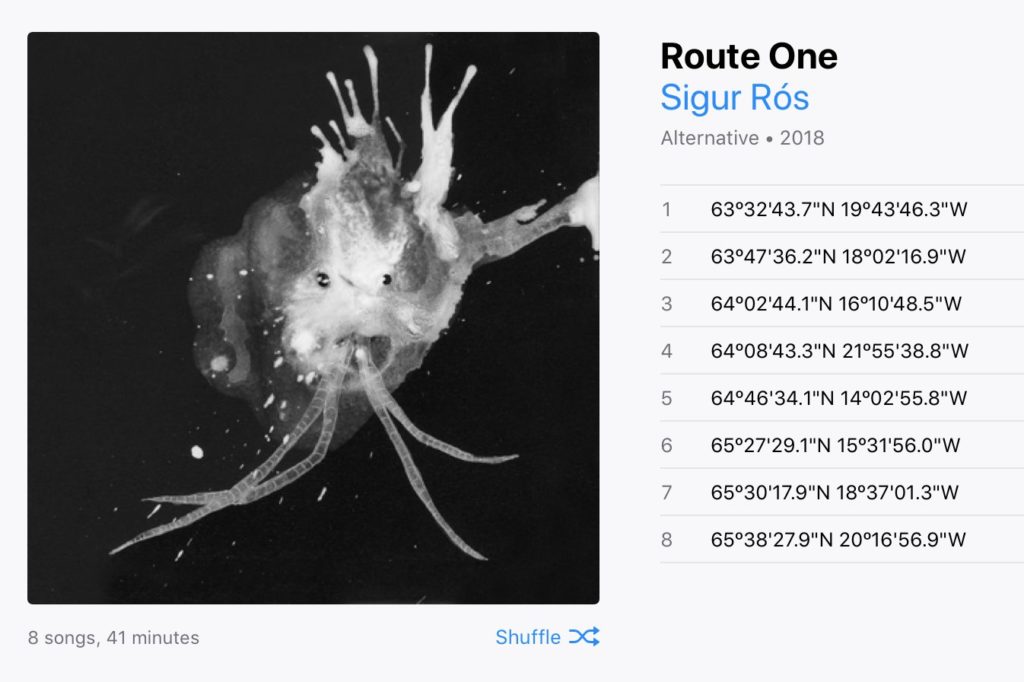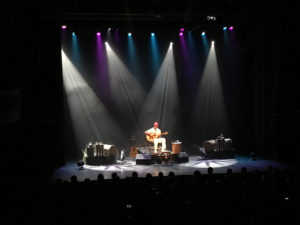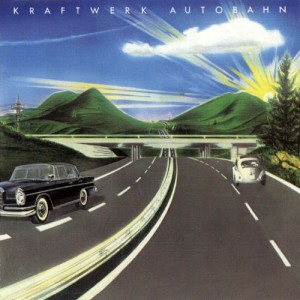Damn the Beasties knew how to dig crates! Bottomless and amazing.
Sigur Ros’ – Route One
Sigur Rós, an Icelandic alt-rock/electronic band, ended 2017 with the release of their newest and possibly most ambient album, Route One. The record is named for Iceland’s actual Route One, also known as the Ring Road, which is a highway that almost fully encircles the island-country, and takes about 10 hours to complete (but I recommend a full week). The connection to this iconic highway does not end at the album title. Each track, of which there are eight, is named after a latitude/longitude coordinate corresponding to a specific location on Route One.

Iceland, which was shaped by equal parts fire and ice (through volcanic and glacial activity), is known for incredible vistas around every corner. Typically, a song explains its meaning through its lyrics, but in the case of this album, the meaning is expressed through the vision and mood of that tiny corner of the world. It is as much a visual experience as an auditory one.
At least, that is the goal. Most listeners will not be listening to the songs at their corresponding coordinates. However, I was lucky enough to go with my family to Iceland and hear half of the tracks on the album at their designated locations. My personal favorite was 64°02’44.1â€N 16°10’48.5â€W, which is located at edge of Lake Jokusarlon, also known as Glacier Lagoon, on the Icelandic south coast. An enormous glacier on the other side of the lake advances slowly toward you. As the glacier meets the lake, chunks of it “calve†and float free in Jokusarlon.

In this track, a slow, soft, and eerie melody is punctuated by a repeating series of small zoom-like effects until all the notes begin to dissolve into meaningless but ear-pleasing noise towards the end of the track. I found it It was difficult to connect the vibe of the track with that of the view; I never would have connected the sounds with icebergs on my own, so how did Sigur Rós reach that point? Did they all agree on the connection, or was only one person on board?
How a place makes one feel is inevitably personal, meaning the artists’ intention for every track in the album will rarely be understood by the listener. For that reason, despite the album’s quality and originality, it is best left as a one-time deal; a blip in the history of music that will be remembered for a long time.
I would highly recommend the album for fans of intense calm. The album can easily be used as a soundtrack for meditation, or for tasks that require a moderate amount of concentration.
Listen:
Below, I whipped up a map of Iceland showing the location of every coordinate/track title. Surprisingly, there does not seem to be a video in which someone has gone to every coordinate and recorded footage of the view so that others do not have to go to Iceland for this experience. However, Sigur Rós was kind enough to create a 3-part, 24-hour video taking the viewer the whole way around the Ring Road, with their album as a soundtrack for the trip. This is the closest we will get for now.
All the track titles of Route One, mapped:
Spotify vs. Apple Music (Why I Can’t Switch)
Finally got around to writing something I’ve wanted to write for years: Why I can’t move to Spotify.
I was open to the experience, but the past two weeks experimenting with Spotify has been pretty disappointing. Game over. iTunes has “gotten†me for 15 years, no reason to jump ship now. I gave it the old college try.
Marvin Pontiac: The Asylum Tapes
“I thought people would be up in arms about pretending to be a black person,” Lurie said in a 2008 interview, “but people were more upset that I pretended to be an insane person.” –2013 John Lurie interview at eMusic
Something seemed fishy about the amazing 1998 The Legendary Marvin Pontiac ‎– Greatest Hits release, on Strange & Beautiful Music. Who was this madman with the lyrical genius of Dylan meets Robyn Hitchcock meets crazy-guy-on-the-corner-by-the-bodega, and where did he come from? How did such an incredible record emerge whole cloth from an artist none of us had ever heard of? Then his biography turned up online, claiming that Pontiac had been:
The son of an African father from Mali and a white Jewish mother from New Rochelle, New York. The father’s original last name was Toure but he changed it to Pontiac when the family moved to Detroit, believing it to be a conventional American name … When his mother was institutionalized in 1936, the father returned and brought the young boy to Bamako, Mali where Marvin was raised until he was fifteen. The music that he heard there would influence him forever.
Plausible? Almost sorta kinda. But why did Pontiac’s voice sound like a more blues-drenched version of New York jazz musician/painter/actor John Lurie (Lounge Lizards)? Oh… because Pontiac was Lurie! Realizing that the whole Pontiac thing was a ruse didn’t diminish the magnetism of that record for me though – it amplified it if anything. Went looking for more, but that was it — just the one audio scrapbook.
Until now. Pontiac (who was supposed to have been killed by a bus in 1977!) just dropped a follow-up recording, The Asylum Tapes, allegedly recorded on a donated 4-track deck while he was confined in the Esmerelda State Mental Institution. This time it’s Lurie solo (the first collection was recorded with John Medeski, Billy Martin, G. Calvin Weston, Marc Ribot), but it’s raw, weird, soulful and full of demented wonder.
New Yorker: So what’s Lurie up to with this project? I suppose it’s no more mischievous, really, than an actor singing in character, and many of our most prized artworks goof around with form, testing the permeable membrane between fact and fiction, between art and something else. … Our hunger for the authentic or the unmediated has mostly begotten us a cavalcade of deeply unreliable things, such as Donald Trump, laminate flooring, fake-fake news, artisanal moonshine, and reality television.
Then again:
Reportedly Marvin’s music was the only music that Jackson Pollack would ever listen to while he painted. This respect was not reciprocated.
Not sure The Asylum Tapes will get us any closer to answering hard questions about how Pontiac ended up in the bughouse, but it’s deep, beautiful, soulful, sort of funny, and totally worth your time. Available for streaming on iTunes, Spotify, etc.
Johann Johannsson, Iceberg
Regency Ballroom SF, April 2017
An immaculate reel-to-reel tape deck with two large white reels stands alone on stage. A technician walks in and presses Play. A woman speaking the names of random numbers in German, filtered through old radio technology – I recognize it immediately as a recording from the Conet Project, a collection of encrypted WWII spy radio transmissions. After several minutes, the 7-piece string ensemble and JoÌhannsson enter and begin to play, looking like Iceland anthropomorphized, a graceful iceberg of a man.

A repeating bass figure starts to wobble, then disturbingly decompose. Sounds like a technology glitch at first, then slowly becomes intentional, but violins maintain composure. JoÌhannsson rewinds the reel; the deck itself is mic’d, so we hear 1/2″ tape flapping against hardware as it unravels. Now the descending staircase of “Flight from the City,” drawn out for live performance. Strobe lights, but gentle, not like disco. I see bombed out Aleppo suburbs, hopelessness, then something trans-dimensional too, an arrival (hope) over the top. JoÌhannsson goes into ritual mode, holding the next reel from his stack up to the light, acknowledging its hidden contents, then carefully slides it onto its spindle and threads the tape. More spy voices. A bass tone rises up, frequency perfected to vibrate the human spleen, maintained. Something rhythmic, almost, in wide-open fields. JoÌhannsson moves slowly to his piano, something exactly halfway between classical and performance art. The performance is filmic, ethereal, thick, but with plenty of open air. You want to close your eyes, but can’t. JoÌhannsson threads another tape.
Seu Jorge Plays Bowie at Regency
Still reeling from last night’s Seu Jorge performance of David Bowie songs from original recording of Wes Anderson’s “Life Aquatic with Steve Zissou.” Twelve years later, and almost a year after David Bowie’s death, Jorge is touring solo with his collection of Portugese-language Bowie covers, as fresh and raw as they were back then. Surrounded by things found in the sea and with a captain’s wheel center-stage, underlit by small flames and overhead lights projecting slowly spinning turbines, we caught him at SF’s Regency Ballroom, all woodsy and Brazilian street-smart (“In case you didn’t know, black men in Brazil don’t listen to rock and roll…”). Set list: Changes, Pretty Thing, Rebel Rebel, Starman, Lady Stardust, Rock and Roll Suicide, Suffragette City , Space Oddity, Five Years, Life on Mars, Queen Bitch.
Bowie’s In Space
Proto-Bowie – a very different “Space Oddity” from the version we’re used to hearing. Almost comical in its innocence, but what makes this track so iconic is the that it perfectly captured the fear aspect of space travel, which wasn’t much talked about in the go-for-it Space Era. After seeing this, the Flight of the Conchords tribute makes much more sense – their costume echoes were perfect.
Bowie’s original version of Space Oddity:
Flight of the Conchords’ “Bowie’s in Space” tribute:
Miss you so much, Starman.
Remove Duplicates, Fix Broken Album Art in iCloud Music Library
Apple Music + iCloud Music Library is a brilliant pairing, and finally lets us access our personal music collections from anywhere. But it’s not without its warts – duplicated tracks and bad/missing cover art has been a sore spot for iCloud Music Library users since the service launched. In my first piece for Medium.com, I walk readers through the reasons – and the fixes – for those two problems.
Yankee Hotel Foxtrot – Numbers Stations / The Conet Project
“I listened to the Voice of America and Moscow Radio and eventually came across shipping and aircraft stations.†“I was able to find an explanation for those. Then I heard the strange voice — someone saying, ‘Papa November’ for five minutes while a snake charmer’s flute played in the background. And there was no explanation anywhere.†— Anonymous forum post
One might imagine that spies since the end of the cold war would be communicating over the interwebs, using AES-256 crypto. Probably not via SnapChat. You might be right. But not entirely. Since the Berlin Wall came down, the number of secret communiques being sprayed out over old-school shortwave radio to real-life spies has actually increased, leaving legions of hackers and radio nerds speculating about their origins and purpose.
So what kinds of messages do spies receive from their masters? No one knows – they’re perfectly encrypted, via the ancient but theoretically unbreakable one-time pad technique. In the age of Heartbleed SSL vulnerabilities and NSA backdoors into computer systems of all kinds, spy orgs have been broadcasting encrypted messages on the public airwaves for more than 50 years. But rather than cold streams of binary data, they’re transmitting the voices of little girls and old men, speaking strings of letters, numbers and random words over shortwave. Despite transmitting without discrimination to anyone with a shortwave receiver, no one has ever been able to crack a single message. Listeners who stumble into one of these stations are likely to hear something like this:
Continue reading Yankee Hotel Foxtrot – Numbers Stations / The Conet Project
Kraftwerk 3D Live
Soon after their very early Can-like Krautrock years, Kraftwerk began to develop and refine a hardcore man-machine aesthetic, imagining themselves as cyborg musicians, as much enslaved by technology as liberated by it. The amazing thing is that the band-machine has been able to sustain itself on that track. Almost any other group would have gone on to other things after the vein ran cold, but Kraftwerk continue to tap the mineshaft of digitalized culture as deep as it wants to go.
As a boy in the late 70s, I used to sit on the shag-carpet floor of my basement bedroom and gaze into the cover of Kraftwerk’s Autobahn, a pair of giant Koss headphones connected to a glowing analog amp by a long green spiral cord, mesmerized by the pulsing, organic, yet also completely artificial sound of this strange German synth group. I imagined myself driving the beige VW bug, watching the black Mercedes zoom past in the opposite direction, as oscillators, generators and patch bays synthesized the sights and sounds of life in a place  called “Germany,” where everyone could drive as fast as they damn well pleased and the album covers went on forever.





